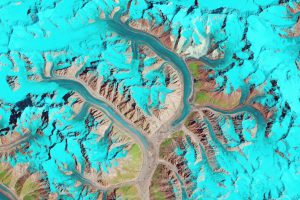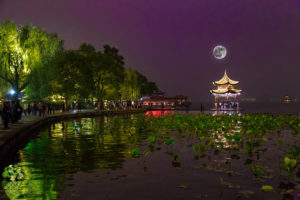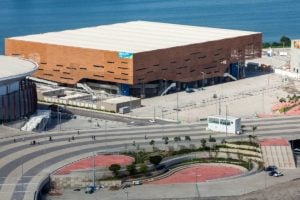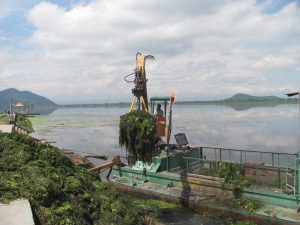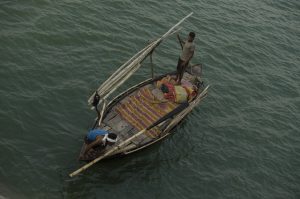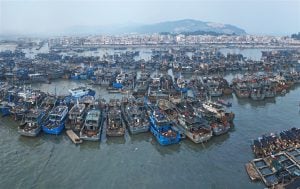In March 2016, India passed the National Waterways Act (NWA), which marks 106 rivers to be engineered into cargo-carrying waterways. The rationale is that shipping is “greener” than road traffic. But, says Nachiket Kelkar of the Ashoka Trust for Research on Ecology and the Environment, “There has unfortunately been barely any debate on the ecological and social risks the NWA poses to river biodiversity and to the communities that depend on the river.”
The importance of riverine ecology, and of livelihoods needs, seems to be absent from the radar of not just the administrative and political circles, but also among prominent environmental and scientific groups.
See: The dolphin, the fisherman and the holy river
See: Ganga river dolphin faces extinction
As per the plan, National Waterway 1 (NW1) will go from Allahabad in Uttar Pradesh to Haldia in West Bengal along the Ganga and then along its arms – the Bhagirathi and the Hooghly. It will involve the construction of more barrages along the river, and heavy dredging of silt, so that a width of 45 metres and a depth of 3 metres can be maintained throughout. This would enable passage for barges carrying 1,500-2,000 tonnes of cargo.
![A turtle finds refuge on a silt island [image by Arati Kumar-Rao]](https://dialogue.earth/content/uploads/2016/08/turtle_silt_island.jpg)
The barrage, meant to flush the Hooghly and save Kolkata port from siltation, has had unintended consequences downstream as well.
Kelkar, writing for the South Asia Network for Dams Rivers & People, has analysed the NWA and clearly called out its implications. Now, as he and I sit by the Ganga watching the sun haemorrhage into the river, his observations come alive.
![The sun setting over the Ganga , the blind dolphin's habitat [image by Arati Kumar-Rao]](/wp-content/uploads/2016/08/lower_ganga.jpg)
Dangerous depth
We see a dredger silhouetted against the fiery orange shimmer of the river. It scoops up sediments from the river bed and plumes it back into the main channel. This is crucial to maintaining navigability of NW1, given the Ganga’s heavy sediment load – and it is also a potential death knell for aquatic species.
“Such dredging dislodges river sediment, thereby destroying fish breeding grounds, habitats for endangered fresh-water turtles, fishes, sensitive aquatic invertebrates, and other organisms. In particular, substrate-breeding fish species are negatively affected by dredging and might even become locally extinct following failed breeding. As a bulk of fisheries depends on benthic (bottom-dwelling) fishes in most of India’s larger rivers, this will mean important threat to the sustainable production of fish in these systems as well,” Kelkar wrote.
As we travel along the river, a more sinister fallout of dredging comes to the fore. The plume that the dredger jets into the river’s main channel settles further downstream and functions like a plug. This plug heightens the riverbed in the centre, and deepens it by the shores. Imagine a “W” shaped river bed, with its elbows resting near the shores. In its turn the river, obstructed by these plugs and trying to find the path of least resistance, rushes into and over these deep channels, scouring off silt from under the concrete of the ghats.
This is where locals and pilgrims take a dip in the holy river. Thus far, no one had any reason to expect a sudden deep fall off. But over the last six months, since dredging has become regular in the Vikramshila Gangetic Dolphin Sanctuary (VGDS), there have been 20 deaths by drowning in Bhagalpur’s Barari Ghat alone – people washed away because the ground beneath their feet was replaced by fast flowing undercurrents.
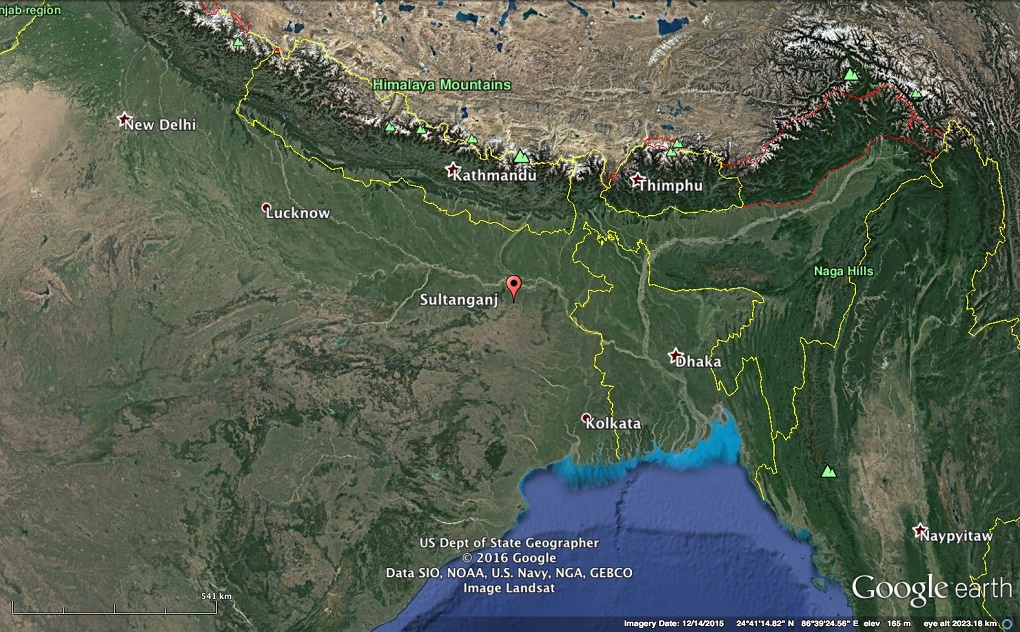
Moreover, to state the obvious, dredging should not be happening in the sanctuary, much less during the vital fish-breeding season.
The plot thickens with the non-appearance of the dolphins.
Where have all the blind dolphins gone?
The Gangetic dolphin is almost completely blind. Evolving in silty, murky environs for over 30 million years, it has all but lost its eyesight. Its eyes have no lenses, and it can only sense the direction of diffuse light. It lives by echolocation; sound is everything to this most ancient of all cetaceans. It navigates, feeds, avoids danger, finds mates, breeds, nurses babies, and lives by echolocation.
What effects will the sound of the dredger, and continuous navigation by large barges and tourist ships have on the blind dolphin?
Ongoing research by the Vikramshila Biodiversity Research and Education Centre (VBREC) has predicted local extinction of Ganges river dolphins from many rivers without adequate flow. River dolphin hearing of lower echolocation frequencies can be masked by dredging and vessel engine sounds, which might seriously limit their ability to find food and navigate. Also, the physical upheaval of river sediment caused by dredging appears to be disturbing to blind river dolphins.
Kelkar’s team has also identified the negative impacts of heavy dredging on blind dolphins near Bhagalpur.
“River dolphins, in May 2014, moved about two kilometres downstream from a regularly used hotspot area near Barari, Bhagalpur town and stayed there for nearly one full week during which the Inland Waterways Authority of India conducted intensive dredging operations near the Vikramshila Setu,” the team wrote. Surfacing frequency of the dolphins (breathing time between dives) reduced approximately three times compared to a natural dive-rate of 1.5-2.5 minutes during feeding peaks.
“In dolphins, this is a clear indication of stressful physiological and body conditions,” Kelkar says. “Further, Ganges river dolphins are highly vocal in normal circumstances, but their acoustic activity was noted to be much lower than on an average non-dredging day. Also, river dolphin mortality due to boat propeller hits has been recorded on a couple of occasions from the same area. During the movement of tourist cruise ships, we observed that the impact of loud sounds produced by the engines lasted for over two minutes – in which river dolphin diving behaviour showed signs of suppression.”
Clearly, dredging is not dolphin-friendly. Over 90% of the endangered blind Gangetic dolphin population overlaps with the proposed national waterways. And this is India’s National Aquatic Animal.
Even if the dolphins had to move, where would they go? The dredgers and barges would be almost everywhere. After I left, the VBREC team did a short survey on this stretch of the river and confirmed that the dolphin sightings in short stretches around Bhagalpur and Kahalgaon have fallen 66-75%. There have been whispers of dolphin deaths, which are still unconfirmed.
Falling waters
In the pre-monsoon season of 2016, water levels in this stretch of the Ganga are at their lowest ever.
![The marks on the rocks show how low the water has fallen [image by Arati Kumar-Rao]](https://dialogue.earth/content/uploads/2016/08/waterlevel.jpg)
The Ganga and upstream tributaries have been dammed several times over, diverted into canals, sucked up for irrigation, and syphoned off into power generation.
While the monsoons may make it seem like there is a “surplus” of water, it is dry season flows that should be the determining factor. And dry season flows in most of India’s rivers are dismal. There is also the rather inconvenient matter of a rapidly receding Gangotri glacier, which is now receding at 10-22 metres a year. At some point, the freshwater available will begin to diminish.
Add to that the inherent hazards of shipping cargo along ecologically invaluable ecosystems. The consistency of mishaps in the Bangladesh Sundarbans, including an oil spill, should set alarm bells ringing.
The Ganga’s waters feed and support 600 million people. Misguided engineering has already contributed to disastrous social and ecological outcomes (Farakka being just one case in point); mishaps and more engineering may just be the proverbial last straw that breaks this camel’s back.
One evening, after crisscrossing the river taking depth readings and becoming increasingly alarmed at the pronounced “W” of the channel we were in, we climbed an ancient granite outcropping in the middle of the Ganga. Squeezing between and clambering over rocks, half-climbing a tree to reach nearly 100 metres above the river for a bird’s eye view, we watched yet another day dissolve.
It is the last day of May. The waters of the Ganga should have started to rise by now. But the depth meter shows a lower value than two months before. Either there is less melt water this year, or whatever had come down from the Himalayas is impounded behind dams.
Holy water is to be had for cities (that can now be purchased online), water is channelled for farmers and sucked for power. What is left? No water. No fish. No livelihood. No dolphins.
Arati Kumar-Rao is a freelance journalist based in Bangalore. She can be contacted at [email protected]
The work on this report was enabled by a grant from thethirdpole.net and the Earth Journalism Network
An earlier version of this report appeared in The Hindustan Times
![<p>The Ganges dolphin [Image by WCS Bangladesh Program]</p>](https://dialogue.earth/content/uploads/2016/05/GangesRiver_dolphin.jpg)
